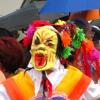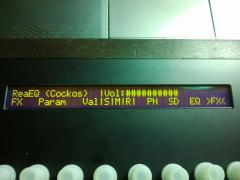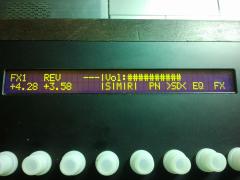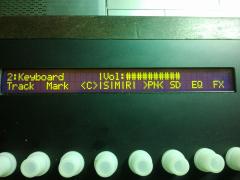-
Posts
279 -
Joined
-
Last visited
-
Days Won
7
Content Type
Profiles
Forums
Blogs
Gallery
Everything posted by John E. Finster
-
Hi, I´d like to give another update on my situation. 1. I installed a heatsink onto the 7805 and this seems to fix the problem with the displays going crazy, I didn´t have a dropout since then. Thanks again, Duggle, for the tip! 2. I was also able to fix the problem with the cut off characters when using the mcu host message and the ^txt56 command. Instead of using the ^cursor command I defined a seperate RECEIVER event for every occuring cursor position inside the sysex stream from the mackie protocol. For Reaper there are 16 ( 2 for every track -> 1. and 2. line ) and for Ableton there are 2 ( 1. and 2. line ). Every receiver became it´s own lcd position. 3. I´m still working on the problem with missing pixels/characters. For the startup of my box I set up an *.NGR script, that first locks the faders, then performs 5 lcd updates and then unlocks the faders again. That works on a startup. I tried using a script with lcd update commands for other functions that require screen changes, but unfortunately the fadermotors seems to react on a meta event and "twitch" whenever a meta event is executed. This can cause small, but sometimes very annoying parameter jumps. This approach doesn´t seem to work as a permanent workaround for the situation. That would be it for now. I will report back if anything new comes up. my regards
-

LED VU Meters, Encoders and SSD1306 Displays
John E. Finster replied to ibanman555's topic in MIDIbox NG
I believe so, yes, using the Mackie Protocol from Klinke. But I´m not completely there yet. I was able to display the meters on my ssd1306 displays and generally they work, but there are a few things I have to work out before I could say, they´re completely usable. The problem seems to lie inside the Mackie Plugin from Klinke. Normally (with the MCU) the meters are activated by a sysex string followed by a stream of Note and Aftertouch events to transport the meter values. I was able to reproduce the stream, so my meters are "twitching", but I´m still missing the proper sysex string. Same goes for the MTC display, btw. As I said, I believe it´s doable, but there has to go a bit more work into it. -

LED VU Meters, Encoders and SSD1306 Displays
John E. Finster replied to ibanman555's topic in MIDIbox NG
A possible compromise in this case could be combining different protocols. I don´t have Protools, but I believe, it also supports Mackie Protocol. It might be possible to attach a (MB_NG-) meter bridge to your faders which is driven with Mackie Protocol. There might be issues to work out if you want to sync both "elements" (e.g. fader bank switching,...). But as said, I don´t know Protools and its possibilities on that area. I guess you will have to set up a lot triggers and translations e.g. with midiox and others, but so far as I understood, you are already doing this to get your faders going. How can your Fader boxes be connected to your daw? What kind of protocol are you using now? Are there other (midi based) protocols inside Protools you could exploit? Novski is certainly right about Avid, they´re a pretty uncommunicative bunch when it comes to their products. The only possibility one has to get behind the curtains is to reverse engineer their gear. But even then I believe there are technologies involved, which can´t be emulated with a Midibox Controller. my regards -

LED VU Meters, Encoders and SSD1306 Displays
John E. Finster replied to ibanman555's topic in MIDIbox NG
Hi, you would need some documentation for these surfaces which contain the sysex implementaion (assuming the meters are transported via sysex). Once you have this, you can set up a receiver event inside MB_NG that can get the sysex events and "translate" them into led or lcd events. I know, this is possible for the Mackie Protocol. I don´t know if there´s a public "implementation chart" available for control 24 though, you might need to reverse engineer this, if you can get your hand on one of those surfaces. Here you can find a conversation on the Reaper forum regarding this topic. I don´t know, how far they have come, but it might be worth a look. my regards -

Midibox 64, how to program Special Function buttons ?
John E. Finster replied to docdune's topic in MIDIbox HUIs
Hi, I can´t tell if it is possible from inside the midibox to assign special functions to buttons, but there is a small app an the midibox_64 site here wherein you can do that. But it is Windows only... my regards -
Ok, which program did you load inside the MF tool? Mackie protocol or something else? Which fader did you touch? Are you experiencing any problems when you move the fader you touched? Like the motors preventing you from moving the fader? Are you using a laptop? If so, are you running it on batteries or on a psu when you are using the MF module? A lot of questions, I know. But answering them could bring us closer to a solution. my regards
-
Can you post a few lines of the midi input when you touch one fader? Maybe 30-40 lines?
-
This is strange indeed. What kind of faders are you using?
-
Try to start at the most left side (0) and then move the slider slightly to the right (from 0 to 1 to 2 to 3....) and touch and release the fader every time until you find a setting that fits.
-
Hi Nick, the expected behaviour would in fact be If you get a constant stream of on/offs you have to adjust the touch sensor sensitivity in the MF tool inside Mios Studio. my regards
-
Ok, after your additional descriptions it really seems that there is a problem on the LPC17 core. The problem on my side would be to narrow down where this problem is, a remote diagnosis from here can be very hard. You can try/check a few things: 1. What kind of computer are you using? PC or MAC? if you are on a PC, I suggest you install the gm5 driver, it´s much more stable than the native windows driver. 2. Visually inspect all the soldering points on the board. 3. If you have access to a multimeter, check the complete core for the expected voltages (look at the LPC17 schematics). 4. Check all the parts, especially those which has a polarity and all the ICs if there are put in the right way. my regards
-
Hi, the red led on the LPC17 core is lit, when some kind of data is processed (like the hdd led on a computer). If there´s a short on the DIN module this would be normal since it processes data continously (impulse from din -> midi data out). I´m a little confused about that button event you posted because it wouldn´t really make sense if it looks that way. Did you post it here exactly like in the *.ngc file? To test a bit further, I´d suggest you create a new *ngc file and insert some simple button events with an id from 1 to 32 and the midi event NoteOn and key from 1 to 32 (to test all input pins on the DIN): EVENT_BUTTON id=1 type=NoteOn key=1 EVENT_BUTTON id=2 type=NoteOn key=2 EVENT_BUTTON id=3 type=NoteOn key=3 EVENT_BUTTON id=4 type=NoteOn key=4 ........ EVENT_BUTTON id=32 type=NoteOn key=32 After that you load it and look at the midi in monitor inside Mio Studio. If there is a continous stream of midi events still coming in, just let it stream for a few seconds and then cut the power of the LPC17 core (to stop the stream ). Then you can study the stream and see, what kinds of notes appear in it. This could help narrowing down where the short sits. my regards
-
Hi, my first guess would be a short somewhere. That is sort of what a button would do, it would close the circuit between a DIN pin and ground. What kind of key values are recognized in Mios Studio when you are using the NG Default script? Maybe this could help narrowing down the error? my regards
-
Hi, in the Mios8 repository there is an app, which can change the ID of a PIC, if you would like to try that: (root)/trunk/apps/troubleshooting/change_id I haven´t used it before myself, so I can´t tell you, if it works, TK gave my this info once. my regards
-
Hi, I made the "bug" work again :D . My track leds always show the selected track and my group leds always show the selected group inside the pattern screen now. I looked at the old source revisions and investigated, what you changed from 4.019 to 4.020. I´m sorry for being overly excited about this, even I considered this, if at all, a mere aesthetic issue. But somehow I couldn´t let this go.... And now, I don´t have to :laugh: . For now at least.... my regards
-
Hi, "autoload off" means, a file is not loaded automatically anymore, when you upload it onto your box or edit and save it in the editor. If you disable this feature via Mios terminal, you can only load your scripts if you use the "load <script.ngc>" command in the terminal. The default script always gets loaded, when you power up your box. my regards
-
Hi, when you power up your midibox_ng the default.ngc is loaded. You can load your script by typing "load 8x8" into the terminal of Mios Studio. If you want your script to load up by default you can either save your 8x8.ngc as default (you load your script and then type "save default"). This didn´t work always in my case though, I can´t tell you why. Or you can open your script with the editor, copy all the content and insert it in the default.ngc manually. my regards
-
Hi, this is a little something I whipped up today. The Frontier Alphatrack was my favorite midi controller and I used it a lot until it broke down some day. Today I´m into something a little bigger, but I always thought about integrating some parts of the Alphatrack protocol into my Midibox. So I created a MB_NG Patch that emulates the Alphatrack, which I want to share. The Alphatrack´s host message sits on the right side of the screen. The other stuff on the left side (Volume bar, Solo/Mute/Rec state and "Vpot"assignement) I put in, because I created this script with my SEQ4 and this looks more clean than using the SEQ4´s leds. For the Alphatrack clone a 2x16 character lcd is sufficient, but I think it doesn´t hurt to have a little more lcd space for custom labels. Instead of the fader I´m using an encoder, the volume level can be reflected on the lcd, the touch sensor is replaced with a buton event. The original Alphatrack features touch sensitive encoders, which is a very nice and handy feature. In my design I also replaced these touch sensor events with simple button events, but with some metal-shaft encoders and metal encoder knobs one can easily build some touch sensitive encoders. All other buttons and leds are assigned in the NGC script, just the hw_ids would have to be adapted. The MB_NG Firmware has to be modified a little bit, inside mbng_event.c a number has to be altered: u8 x_wrap = (*stream == MBNG_EVENT_SYSEX_VAR_TXT56) ? 56 : 64; has to be changed to: u8 x_wrap = (*stream == MBNG_EVENT_SYSEX_VAR_TXT56) ? 56 : 16; So that the variable ^txt can set the cursor to the second line after 16 characters. Then the MB_NG source has to be compiled again and uploaded onto the Midibox. I tested it with Reaper (using the genius Alphatrack-Pro extension) and with Reason 5, no problems so far. There are some issues I couldn´t find a solution for yet: 1. Using an encoder (or a fader) for volume doesn´t work completey. One can send the volume value, and the midibox somehow "picks up" the right volume value from the daw, when the encoder is moved. But the Midibox doesn´t receive this value, when it is just sent by the daw. 2. I wasn´t able to recreate the touchstrip from the Alphatrack. I can create 2 buttons with the events for a 1-finger touch and a 2-finger touch, but when I tried to emulate the touchstrip movement with an encoder, it didn´t work I believe this has to do with the pitchbend values. The fader would need to send/receive a 10bit pitchbend value and the touchstrip a 5bit pitchbend value. But the MB_NG only provides a 14bit pitchbend value. This is not really a problem for me, since I wouldn´t use any of those 2 features for my own box, but for a complete clone, those issues would have to be resolved. Maybe someone has an idea for a workaround? Anyway, perhaps this can be of some use to someone. My regards Midibox_Alphatrack.zip P.S. Inside the Zip are the .NGC script and a .NGL script for the extra labels I use on the left side of the lcd.
-
From the album: [John E. Finster] pics and such
-
From the album: [John E. Finster] pics and such
-
From the album: [John E. Finster] pics and such
-
From the album: [John E. Finster] pics and such
-
Hi TK, a pitchbend event with a 14bit value works, but only in one direction. I can control the value (volume fader in daw) with no value jumps, the encoder somehow "picks up" the value when I´m moving it, but it doesn´t get updated, while I move the fader inside the daw. But that´s alright for now. This is a little side project, I´m working on, while I´m away from my main project. I´m with my folks for 2 weeks and I was only allowed to take my SEQ4 with me (strict orders from my wife :wink: ). So I thought I could work an some other ideas. Many thanks for your advice. My regards
-
Hi, can anyone tell me if it is possible to send/receive a 10bit pitchbend event via encoder? I want to emulate a fader, that uses this. The event has the form of "E9 xx yy" while xx refers to 3 LSBs and yy to 7 MSBs. In Midiox it looks like this when I drag the fader up. Thanks. my regards
-
The last few days this forum seems to be overrun with Spam. - Eudenut - cicEncorseTes - Siegspurine





